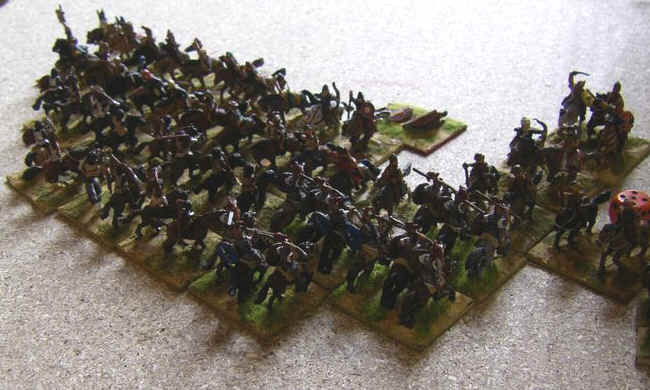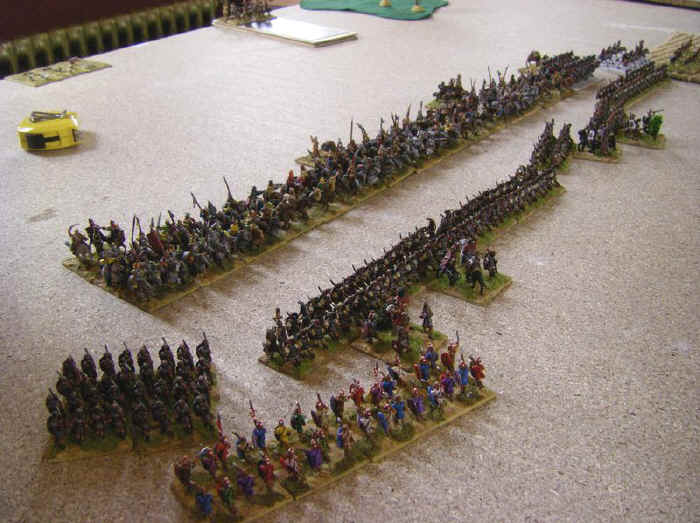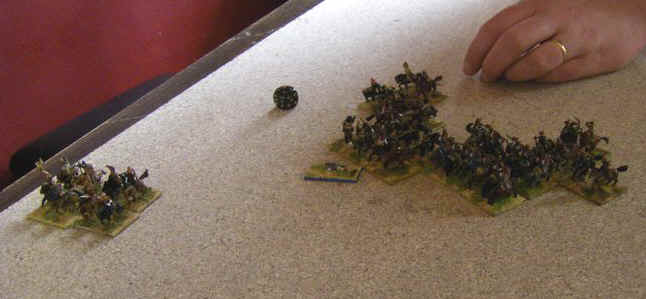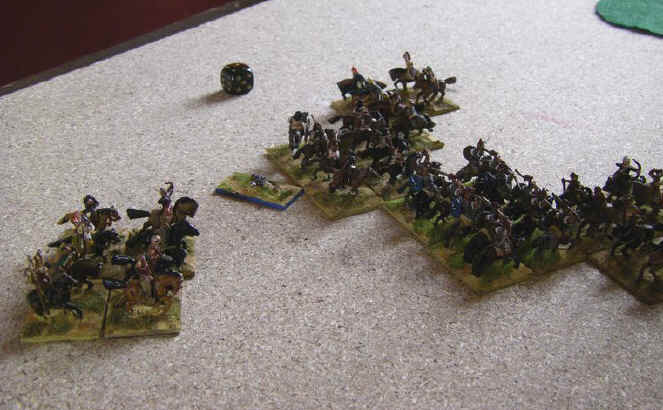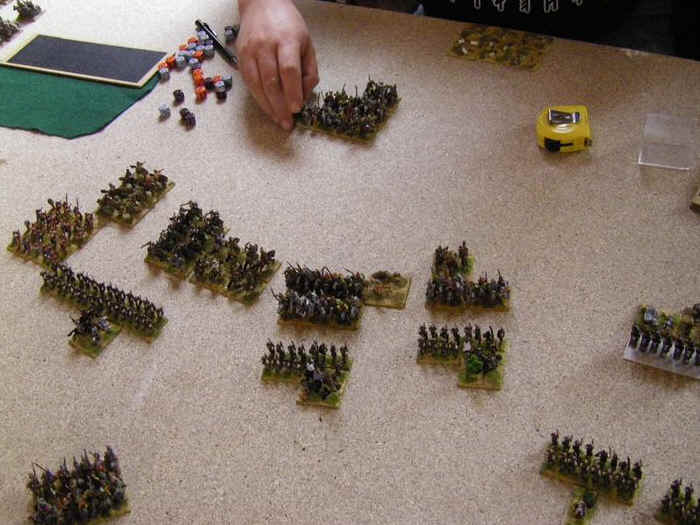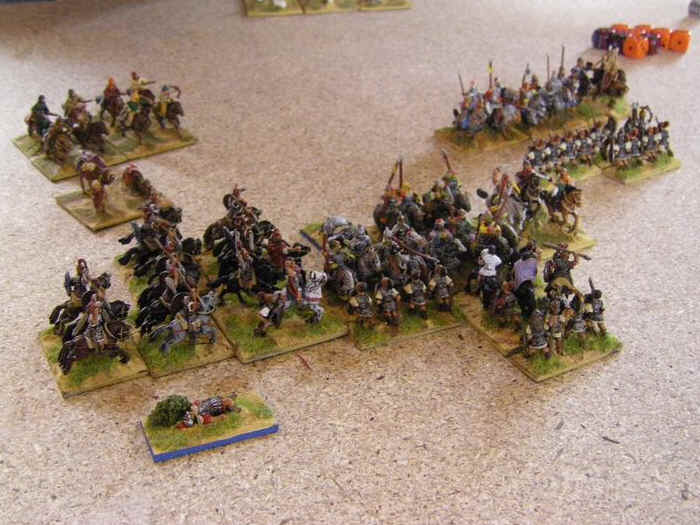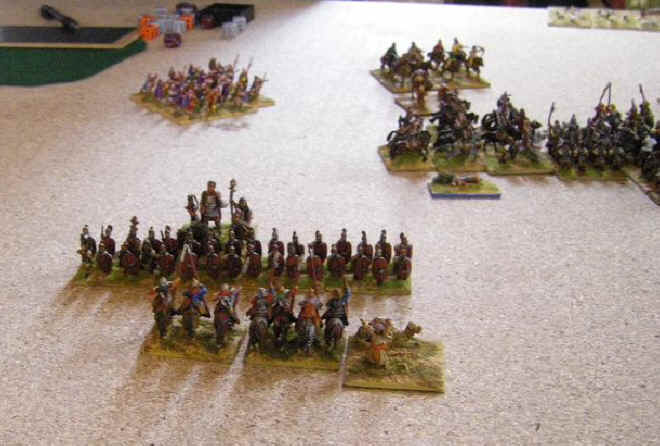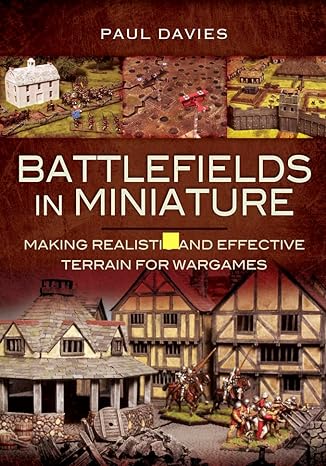Field of Glory Wargaming at The Madaxeman Invitational May 2009
After some rather fine chips and fish at the Seashell it was time for the afternoon game. In another historical matchup, I was facing the Parthians who's list is available here
Pictures of Parthian Troops from my Ancients Photo Directory
 |
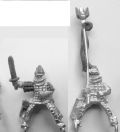 |
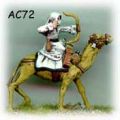 |
 |
You can rate the quality of the above figures by clicking on any of the pictures and then clicking on the 5-star voting buttons. Your ratings will be seen by hundreds of other gamers and will help them select the best figures for their armies!
The terrain all slid off the edges of the table, and we were left with a virtual billiard save for an oasis that allowed me to close down my side of the table and protect my right flank.
The Parthians were advancing immediately - with a a line of intermingled light horse and cataphracts, and a huge slab of light horse immediately down the throats of my less numerous cavalry and light horse win on my left.
The game was a race between the wing and the center to see who could get into combat sooner!
The Light Horse wing won, and relying on greater numbers they decided to stand and fight against the Roman cavalry.
In the middle the legions advanced steadfastly, keeping the Illyrians behind for rear support to the average legions instead of pushing them out forwards as for the last game.
The Romans were slightly surprised to find they had a longer line than the Parthians, but they were very conscious that if they charged, they would be down at impact.
The light horse battle was happening very quickly, as the end of the Roman line broke and was destroyed, leaving only one unit of Numidians and some cavalry to chew up the rest. The Parthian plan of trading units and delaying my flank seemed to be working!
The Parthian cataphracts wheeled into combat along the entire front, ensuring their flanks were no longer available to be charged by the Romans - but the boys in red did have a substantial number of overlaps along the line. A few disruptions after impact saw the Roman line bow against the force of the charge.
The Parthian cavalry on my left were returning to the fray - would they get there before their colleagues collapsed? Yes they would! The Roman cavalry broke free and started moving toward the middle to support their colleagues.
The combat in the middle was see-sawing back and forth, as one legion unit was swept away, leaving a huge hole in the middle of the line - but the rest of the Parthians were being bounced fairly systematically - and also and were shedding bases and picking up cohesion status marker on the way. Ominously, the Roman cavalry were appearing on the far right of the Parthian line...
Finally the left hand side of the Romans attack gained that little extra edge that allowed them to start to win big - in the form of the returning Roman cavalry ! They hammered into the end of the Parthian line and the cataphract units started to break and flee.
The Roman cavalry, now playing a far better game than in the morning fixture, continued to run riot and roll up the Parthian right. With Romans hanging on, the cavalry again came to the rescue.
Even so, with the large number of units of light horse, the battered Parthians were still not beaten. It took the returning Parthian Cataphracts - fresh from breaking through the Roman line - to make another repeated charge into the well-drilled legions to finally succumb to the accumulation of casualties. The Romans won!
Post Match Summary
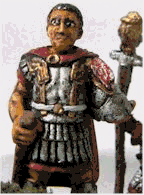 As
Caesar, I am pleased to announce a comprehensive victory for my loyal legions.
As
Caesar, I am pleased to announce a comprehensive victory for my loyal legions.
This was a triumph of arms as I managed to line my troops up in a line, give some of them rear support and advance to fight an enemy committed to fighting me in turn
The bottom line was that our legions were tougher - and more numerous - than the Parthians, and it worked out all OK.
The Patrician cavalry this time did its job of helping beat up some enemy light horse. And because battle was joined almost in the first available turn, they then had time to get into the middle and make a difference - partly as the cataphract battle dragged on for a long time as they did keep bouncing off our legions.
We won. Hoorah!
Hannibal's Post Match Analysis
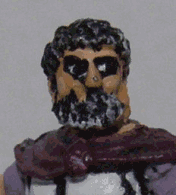 Oh
dear. Victory makes one overconfident doesn't it?
Oh
dear. Victory makes one overconfident doesn't it?
The Parthians lined up, and decided to give you multiple overlaps - admittedly instead of giving you a few flanks - and you eventually ground them down.
That's effective, but hardly going to get your the laurels of the Greatest General Ever to Walk The Soil of Italy (admittedly, I have that trophy on my mantelpiece already, so its technically not up for grabs, but in any case you wont even be getting a cheap plastic copy from the shop in the agora, will you?).
My view is that if the Parthians had stuck their cataphracts together in a big lump they would have won - and you would have had no chance save the dice.
Yet again you got away with it. Good job the competition ended there and then.
The Ancient Army List Index
The Rise of Rome (280 BC to 25 BC) Mid Republican Roman ; Late Republican Roman ; Gallic ; Pyrrhic ; Later Carthaginian ; Ancient Spanish ; Later Macedonian ; Later Seleucid ; Later Ptolemaic ; Attalid Pergamene ; Numidian or early Moorish ; Pontic ; Early Armenian ; Parthian ; Later Jewish ; Illyrian ; Spartacus Slave Revolt ; Bosporan ;
Storm of Arrows - Western Europe in the Later Middle Ages (1300 AD to 1500 AD) Medieval French ; 100-yrs War English (Continental) ; 100-yrs War English (Britain) ; Later Medieval Scots ( Britain) ; Later Medieval Scots (Continental) ; Later Scots Isles & Highlands ; Medieval Welsh ; Later Anglo-Irish ; Medieval Irish ; Low Countries ; Later Medieval German ; Italian Condotta ; Swiss ; Free Company ; Medieval Burgundian ; Medieval Danish ; Medieval Swedish ; Medieval Castilian ; Medieval Crown of Aragon ; Medieval Portugese ; Later Granadine ; Navarrese ; Ordonnance French ; Wars of the Roses English ; Ordonnance Burgundian ; Santa Hermandad Nueva Castilian
Immortal Fire - The Greek, Persian & Macedonian Wars (550 BC - 146 BC)
Classical Greek ;
Early Achaemenid Persian ;
Lydian ;
Thracian ;
Syracusan ;
Early Carthaginian ;
Skythian or Saka ;
Kyrenean Greek ;
Late Dynastic Egyptian ;
Alexandrian Macedonian ;
Later Achaemenid Persian ;
Classical Indian ;
Early Successor ;
Early Sarmatian ;
Galatian ;
Hellenistic Greek ;
Graeco-Bactrian ;
Graeco-Indian ;
Indo-Greek :
Legions Triumphant - Imperial Rome (25 BC to 493 AD) Dominate Roman ; Principate Roman ; Foederate Roman ; Later Sarmatian ; Early German ; Dacian or Carpi ; Ancient British ; Caledonian ; Early Alan ; Jewish Revolt ; Sassanid Persian ; Kushan or Indo-Skythian ; Palmyran ; Early Frankish, Alamanni, Burgundi, Limigantes, Rugian, Suevi or Turcilingi ; Western Hunnic ; Early Visigothic & Early Vandal ; Early Ostrogothic, Herul, Sciri or Taifali ; Early Anglo-Saxon, Bavarian, Frisian, Old Saxon or Thuringian ; Gepid or Early Lombard ; Early Scots Irish ; Early Pictish ; Hephthalite Hunnic ;
Swords & Scimitars - The Crusades (1096 AD to 1311 AD) Early Crusader ; Later Crusader ; Fatimid Egyptian ; Georgian ; Seljuk Turk ; Cuman ; Komnenan Byzantine ; Post Latin Conquest Byzantine ; Ilkhanid Mongol ; Mamluk Egyptian ; Cilician Armenian ; Syrian States ; Khwarazmian ; Ayyubid Egyptian ; Middle Serbian ; Middle Bulgarian ; Medieval Cypriot ; Latin Greece ; Pecheneg ;
Eternal Empire - Eastern Europe and the Rise of the Ottomans (1300 AD to 1500 AD) Early Ottoman Turkish ; Later Ottoman Turkish ; Tatar ; Later Russian ; Later Serbian Empire ; Later Bulgarian ; Later Lithuanian ; Later Polish ; Later Teutonic Knights ; Catalan Company ; Middle Hungarian ; Moldavian or Wallachian ; Albanian ; Timurid, White Sheep Turcoman or Black Sheep Turcoman ; Later Hungarian ; Hussite ;
Decline & Fall - Byzantium and Islam (493 AD to 1071 AD) Early Byzantine; Maurikian Byzantine ; Thematic Byzantine ; Nikephorian Byzantine ; Later Moorish ; Later Visigothic ; African Vandal ; Italian Ostrogothic ; Early South Slav ; Lombard ; Avar ; Arab Conquest ; Early Bulgar ; Ummayad Arab ; Abbasid Arab ; Early North African Dynasties ; Khurasanian Dynasties ; Bedouin Dynasties ; Dailami Dynasties ; Pecheneg ; Ghaznavid ; Western Turkish (includes Khazar);
Wolves From The Sea - The Hairy European Dark Ages Post Roman British ; Early Welsh ; Later Scots Irish ; Merovingian Frankish ; Later Pictish ; Early Slavic ; Middle Anglo Saxon ; Astur Leonese ; Andalusian ; Early Navarrese ; Carolingian Frankish ; Viking ; Magyar ; Great Moravian ; Early Scots ; Rus ; Norse Irish ; Early Medieval French ; Early Medieval German ; Norman ; Early Polish ; Anglo Danish ;
Swifter Than Eagles - The Biblical Book Nubian ; Early Libyan ; Later Sumerian or Akkadian ; Early Nomad Allies ; Old or Middle Kingdom Egyptian ; Hyksos ; Mitanni ; Syro-Canaanite ; New Kingdom Egyptian ; Later Minoan or Early Mycenaean ; Hittite Empire ; ; Middle or Early Neo-Assyrian ; Later Mycenaean or Trojan ; Sea Peoples ; Philistine ; Phoenician Allies ; Neo-Hittite And Aramaean ; Later Hebrew ; Mannaean Allies ; Libyan Egyptian ; Urartian ; Median ; Neo-Elamite ; Proto-Arab Allies ; Cimmerian or Early Skythian ; Neo-Assyrian Empire ; Phrygian Allies ; Kushite Egyptian ; Neo-Babylonian Empire ;
Oaf of Fealty - Early Medieval Europe Feudal Catalan and Early Crown Of Aragon ; Early Hungarian ; Taifa Andalusian ; Feudal Navarrese and Aragonese ; Feudal Castilian Leonese or Portuguese ; Fanatic Berber ; Italo-Norman ; Feudal French ; Imperial German ; Feudal German ; Communal Italian ; Papal Italian ; Early Scots Isles And Highlands ; Feudal Scots ; Early Russian ; Feudal Polish ; Anglo-Norman ; Later Welsh ; Early Lithuanian or Samogitian ; Wendish Prussian or Estonian ; Early Medieval Frisia and Other Free Cantons ; Post-Viking Scandinavian ; Early Plantagenet English ; Later Sicilian ; Early Medieval Irish ; Early Anglo-Irish ; Early Teutonic Knights ; Mongol Invasion ; Early Granadine ; Middle Plantagenet English ;
Empires of The Dragon - China, Korea and Japan Erlitou-Shang Chinese ; Early Northern Barbarian Allies ; Early Zhou Chinese ; Yayoi Japanese ; Early Horse Nomad ; Ko Choson Korean ; Warring States To Western Han Chinese ; Qiang And Di ; Three Kingdoms Korean ; Eastern Han Chinese? ; Three Kingdoms W Jin And S Dynasties Chinese ; Kofun Nara Japanese ; Northern Dynasties Chinese ; Later Hindu North Indian ; Later Hindu South Indian ; Central Asian City States ; Western Wei To Early Tang Chinese ; ; Later Horse Nomad ; Tibetan ; Nepalese Allies ; Parhae Korean ; Late Tang To Five Dynasties Chinese ; Khmer Or Champa ; Thai Allies ; Nanzhao ; Pyu Burmese Allies ; Koryo Korean ; Early Heian Japanese ; Pagan Burmese ; Liao ; Song Chinese ; Xi Xia ; Ghurid Afghan ; Jin ; Late Heian To Muromachi Japanese ; Japanese Warrior Monk Allies ; Mongol Conquest ; Moslem Indian Sultanates ; Medieval Indonesian Or Malay ; Yuan Chinese ; Medieval Burmese ; Ming Chinese ; Yi Korean
Blood and Gold - The Americas Olmec ; Teotihuacan ; West Mexican ; Zapotec or Mixtec ; Toltec ; Chinantec ; Aztec ; Tarascan ; Tlaxcalan Confederacy ; Mayan ; Mochica ; Chanca ; Chimu ; Hatun-Colla ; Canari ; Inca ; Mapuche or Araucanian ; Amazonian Forest Tribes ; Tupi ; Chichimec ; Pueblo Culture ; Mound-Builder Culture ; South-Eastern Woodland Culture ; Timucuan ; Eastern Woodland Culture ; Plains Culture ; Pacific North-West Culture
View My Stats for My FoG Pages



